
The treatment options
For children with epilepsy, there are two options: surgery and neurostimulation techniques. These treatments can reduce seizures frequency and severity, and speed up recovery. Although these treatments aren't FDA-approved, increasing numbers of studies support their effectiveness. Children may have surgery called hemispherectomy. This involves removing a part of the brain which causes seizures. Although it can prevent seizures in children, the procedure is associated with some risks such as reduced motor function and cognitive function, as well behavior problems.
Epilepsy patients often have seizures that last for several minutes or more. These seizures are often accompanied with uncontrollable jerking movement, blank stares, or confusion. Seizures happen in different parts the brain depending on their cause. To control seizures, epilepsy patients may need several medications.
Genetic testing
Genetic testing for children's epilepsy can be a valuable tool in diagnosing and treating the condition. The test will determine whether the child has an epilepsy-causing variant of a gene. The doctor will use the information from this test to tailor his treatment plan.

Families concerned about their child’s condition may be eligible to take the test. It can confirm the original diagnosis, reduce investigations, and provide additional information for family members. Besides confirming the diagnosis, genetic testing can also help physicians find other health problems associated with the child's epilepsy and determine the best course of treatment.
Medications
Medications for children's epilepsies can help control the seizures and prevent side effects. The child's weight, age, and gender will impact the dosage. Depending on the severity of the seizures, the physician may recommend monotherapy or multiple medications. To avoid side effects and adverse reactions, medications for children with epilepsy may need to be modified over time.
It is important that you follow the recommended dose and frequency of medication. Side effects can result if the child stops taking the medication. Parents should talk with the school nurse to discuss their medication schedule. Parents must be aware about side effects and precautions when taking different medications.
Vagus nerve stimulator
Children with seizure disorders such as Landau-Klefner syndrome or VNS can benefit from a vagus nerve stimulator (or VNS). This treatment is particularly effective for Landau–Klefner syndrome. However, other types of epilepsy might also benefit from it. However, it is important to note that children under 12 years of age are not as well-suited as older children.

The vagus nerve stimulator works by sending small electrical pulses to the brain, helping the child to have fewer seizures. It is surgically inserted under the armpit and chest. The small wire connects to the child’s vital nerve through the vagus. It can be activated automatically or manually to interrupt seizures.
FAQ
How do I become a creative health professional?
There are many pathways to becoming a creative health professional. Some people start off as students. Others begin their careers in other areas such as engineering or business.
Some students choose to focus on a specific topic such as health policy, leadership, management or leadership. Some choose to elective courses that examine different perspectives on health or health care.
No matter what path you choose, you will be learning about topics related to healthcare through lectures, readings group discussions, assignments, projects, and assignments. You may also attend workshops, conferences, and seminars.
The program will equip you with the knowledge and skills you need to interact with clients, colleagues, or patients in any capacity within the health sector.
You might even be able to go on to get a doctorate.
What is "health promotion"?
Health promotion means helping people to stay well and live longer. It focuses on preventing sickness rather than treating existing conditions.
It includes activities like:
-
Eating right
-
Get enough sleep
-
exercising regularly
-
Staying active and fit
-
Not to smoke
-
managing stress
-
Keep up with vaccinations
-
avoiding alcohol abuse
-
Regular screenings and checks
-
learning how to cope with chronic illnesses.
What would happen if Medicare was not available?
The number of Americans without insurance will rise. Some employers will drop their employees from their plans. Senior citizens will have to pay higher out of pocket for prescription drugs and medical services.
Statistics
- Consuming over 10 percent of [3] (en.wikipedia.org)
- The health share of the Gross domestic product (GDP) is expected to continue its upward trend, reaching 19.9 percent of GDP by 2025. (en.wikipedia.org)
- Healthcare Occupations PRINTER-FRIENDLY Employment in healthcare occupations is projected to grow 16 percent from 2020 to 2030, much faster than the average for all occupations, adding about 2.6 million new jobs. (bls.gov)
- Foreign investment in hospitals—up to 70% ownership- has been encouraged as an incentive for privatization. (en.wikipedia.org)
- For the most part, that's true—over 80 percent of patients are over the age of 65. (rasmussen.edu)
External Links
How To
What is the Healthcare Industry Value Chain
The entire value chain of the healthcare industry includes all activities involved with providing healthcare services to patients. This includes all the business processes that occur within hospitals and clinics as well as the supply chains that link them to other providers, such as doctors, nurses, pharmacists or insurance companies. The final result is a continuum in care that begins with diagnosis, and ends with discharge.
The value chain is composed of four main components:
-
Business Processes: These are all the tasks performed by people throughout the entire delivery of healthcare. A physician might order medication for a patient, then perform an examination. Every step must be done efficiently and accurately.
-
Supply Chains – All organizations that ensure the right supplies reach the correct people at the right times. An average hospital has many suppliers. These include pharmacies, lab testing facilities and imaging centers.
-
Networked organizations - These entities must communicate with each other in order to coordinate. Hospitals typically have many departments, each with its own set of offices and phone numbers. Each department will have its own central point, where employees can get updates and ensure everyone is informed.
-
Information Technology Systems (IT) - IT is essential in order for business processes to run smoothly. Without it things would quickly fall apart. IT provides an opportunity to integrate new technologies into the system. Doctors, for example, can connect to a secure internet connection to access electronic medical records.